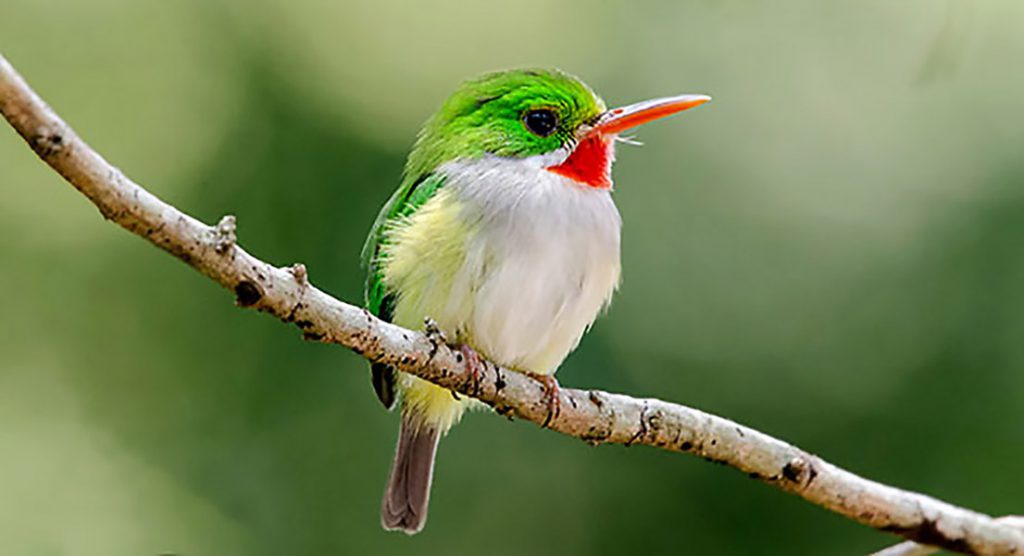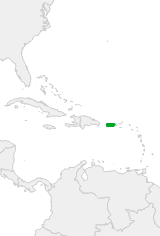 Photo ©
Mike Morel
Photo ©
Mike Morel
Puerto Rican Tody
Regional Species
The Puerto Rican Tody is found in a wide range of wooded habitats across the island of the same name, and occurs from the coastal lowlands well into the mountains. As in all of the todies, the sexes are virtually alike and basically entirely bright green above, with a neat red chin and throat patch, a white malar streak, yellow breast sides, and yellowish flanks. Endemic to the island of Puerto Rico, its local names include San Pedrito, Medio peso, and Papagayo.
Range

Habitat
Puerto Rican Tody is widespread and found in most forested areas throughout the island, including damp forests, humid mountain slopes, montane rain forests, coffee plantations, second growth pastures, riparian woodlands, dense growth in mountains and hills, dry limestone forests, wet and mesic limestone forests, and semi-arid coastal regions. The tody is less common near peaks of the highest mountains and rare in some lowlands, although it is common in lowland arid areas in the southern portion of the island that have dense thickets, such as the Guánica Forest.
Food
Puerto Rican Tody is a flycatching insectivore. In studies with captive todies, they can consume about 40% of their body weight in insects per day. Most food items brought to nestlings are lacewings or moths, and adults show discrimination in which items they consume or bring to the nest. Adults sometimes feed on small Anolis lizards, but feed more frogs than lizards to nestlings. Although the Puerto Rican Tody is considered an insectivore, it has been observed to supplement the diet of nestlings with fruit from the Clusia krugiana tree.
Behavior
Todies are most active on sunny mornings after rain, with activity peaks occurring during March and September. Breeding activity is greatest from February to April, during the dry season, as todies court, build nests, and delineate breeding territories. Puerto Rican Tody bathes in flight in drizzling rain, dew, or wet foliage; they scratch and preen. Todies clean their bill by rapidly stroking the bill base-to-tip against a perch, swiping it on the branch one to four times per side after foraging, regurgitation, cleaning their bodies, or during nest excavation. They also commonly regurgitate to expel indigestible matter, followed by keeping their bill open and gaping. They have not been observed drinking, and likely obtain water from leaves and insects while feeding. Todies ruffle their feathers and shake laterally, then relax and allow the feathers to settle during preening and bathing, feeding, burrowing, displaying to threaten opponents, and by females showing submission. They engage in short flights, and rarely hover. Todies seldom are observed on the ground, and hop rather than walk on the ground. Todies also flick their wings rapidly and repeatedly, usually during preening, bathing, or active feeding periods.
Nesting
Puerto Rican Tody excavates a curved burrow into an earth bank with a nest chamber at the end. Excavation begins in early September although the early burrows are not used, and continues through June, with the average excavation taking 8 weeks to complete. Burrows typically have a nearly circular entrance, averaging 3.4 cm wide and 3.6 cm high, with the entrance typically placed 0.46 m above the ground in a 1.1 m tall bank. The mean length is 30.5 cm in wet forests or 26.9 cm in dry scrub, terminating in an enlarged and slightly depressed chamber for the eggs. The chamber averages 11.3 cm long, 9.8 cm wide, and 6.9 cm high. Male and female todies excavate their nest together, digging alternately and leaving to forage together after working.
Appearance
Size and Shape
Puerto Rican Tody is small and chunky. In adults, wings are short and rounded. The tail is two-thirds to three-fourths as long as the wing, and has a rounded end, with narrow rectrices that have broadly rounded tips. Claws are large, strongly curved, and acute. The bill is broad and long, and immature birds have a shorter bill than adults
Color Pattern
The Puerto Rican Tody has bright green on the back like most species in the genus Todus. They have a red throat and lower mandible. The flanks are yellow with a white breast. The upper parts of the body, and sides of head, are plain green, with a slight blue coloration posteriorly. The sides of the head are usually a clearer green color. The chin and lower foreneck are white, as well as the central under parts of the body. The wing edge is white, and the under wing coverts are sulfur yellow. Immature lacks red throat coloration and chest may be striped with dusky gray.
Similar Species
Puerto Rican Tody is the only endemic tody on Puerto Rico; other tody species do not overlap the range of this species. Additionally, all other species of todies have some pink with yellow or yellow green coloration on their flanks, whereas Puerto Rican Tody has no pink on the flanks. Puerto Rican Tody is the only small species that is primarily bright green in Puerto Rico, other than hummingbirds.
Did you know?!
- Although some birds use a "favorite perch" for foraging and roosting, the tody seems to only use a favorite perch before entering the nest.
- Todies defecate while perched, and do not defecate in their nest burrows.